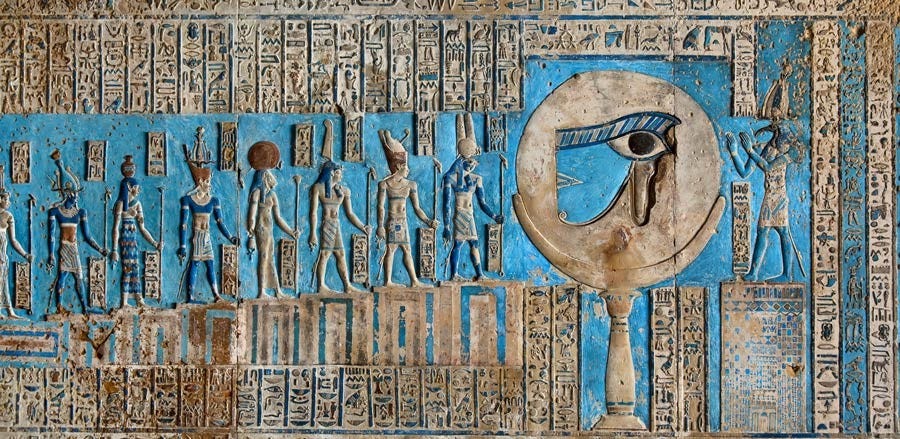Hidden Hue: Why Ancient Civilizations Failed to See the Color Blue?

Historical evidence reveals that humans possess the remarkable ability to render certain physical appearances invisible if they do not focus on them, including something as fundamental as a color. Specifically, the color blue. While our eyes can perceive among approximately one million colors, it remains unclear how differently each person experiences them.
Surprisingly, recent research has revealed that blue—the color of a wide variety of features including the sky, oceans, flowers, and even clothing—was largely unnoticed throughout much of human history.
In simpler terms, the concept of "blue" as we know it today simply didn't exist in ancient times. In fact, in 2015 Buisness Insider reported that “the evidence for people not seeing blue dates all the way back to the 1800s.”

Blue’s Noteworthy Absence in Ancient History
The tale of blue's absence in history begins in 1858 when William Gladstone, later Chancellor of the Exchequer and Prime Minister of Great Britain, read Homer's The Odyssey. Gladstone noticed Homer described the sea color as “wine-dark,” not “deep blue,” sparking his inquiry. He counted color references in The Odyssey, finding black mentioned nearly 200 times, white about 100, but no mention of blue.
Extending his research, he discovered that references to the color blue were absent from all Greek literature. German Jewish philosopher Lazarus Geiger followed Gladstone's lead, analyzing ancient Icelandic sagas, the Koran, Hindu, Chinese folklore, Arabic, and an ancient Hebrew version of the Bible. Geiger found that blue was missing in these texts too. His findings underscored a widespread absence of blue in ancient writings, reshaping our understanding of historical color perception.
In the absence of specific terminology to describe the color blue, scholars were compelled to entertain the possibility that ancient societies didn't perceive this hue, leading to its omission from their lexicon. Were the visual faculties of ancient peoples markedly distinct from our own? What accounts for the apparent oversight of blue in their observations?
While the motives behind Homer's portrayal of the “wine-dark” sea remain speculative, evidence suggests that ancient individuals possessed the same biological capacity to discern blue as modern humans. Could the absence of linguistic representation have influenced the way they experienced the color? If blue failed to constitute a unique color category, could it have been perceived as a type of green, or simply overlooked? Exploring these questions offers intriguing insights into the complexities of ancient cognition and linguistic expression.

Exploring the Ambiguity Between Blue and Green
In his quest to trace the emergence of “blue” as a distinct color in language, Geiger uncovered a recurring trend across diverse cultures worldwide: the sequential development of color terms. Every language initially embraced words for black and white, symbolizing darkness and light, followed by red, associated with blood and wine. Subsequently, yellow and green entered linguistic lexicons, with blue consistently lagging behind as the last hue universally recognized.
The Goldsmiths University of London psychologist Jules Davidoff initiated a pioneering research project in 2006 with the Himba tribe in Namibia. This tribe's language lacks a distinct term for blue and blurs the distinctions between green and blue. Documented in a BBC film, the study involved subjecting tribal members to tests probing their capacity to perceive blue.
When presented with a unique pattern featuring one blue square amid 11 green squares, the majority of participants encountered difficulties in distinguishing the divergent hue. This resulted in protracted response times and heightened errors compared to counterparts fluent in languages distinguishing between blue and green.
Most of the Himba tribe members had more difficulty recognizing which of the squares was a different color. Those who could took far longer than Westerners would to spot the blue square. The experiment not only suggested that language influences perception, but also unveiled the Himba language's richness in describing various green shades.
This has led to the belief that without words to describe them, distinguishing colors becomes impossible. Therefore, before the linguistic recognition of blue, humans would have perceived blue objects as shades of green.

Delving into the Birth of the Color Blue
In the annals of history, ancient Egyptian society emerges as the trailblazer in embracing a distinct term for the color blue, owing to its pioneering development of blue dyes. This innovation found its vibrant expression in the renowned hue known as Egyptian blue. This stunning color featured in artworks such as the tombs of Mereruka from the Old Kingdom (2600 to 2100 BC).
Blue, imbued with symbolic significance, came to symbolize the life-giving Nile River, the expansive sky, and, in later epochs, the very cosmos, creation, and fertility.
However, the quest for this coveted hue was not without its challenges, since the only natural source of blue stemmed from the rare and costly mineral lapis lazuli, mined in what is now Afghanistan.
According to Vitruvius, the esteemed 1st-century Roman architect and writer, the creation of Egyptian blue necessitated a blend of sand, copper extracted from minerals like azurite or malachite, and natron—a naturally occurring amalgamation of sodium compounds, including sodium carbonate. Such meticulous formulations and techniques underscore the ingenuity and resourcefulness of ancient civilizations in their quest to capture and harness the elusive essence of color.
Considering the fascinating tale of how blue evolved over time prompts a thought-provoking question: What else might we overlook in our daily lives, obscured from view simply because we lack the vocabulary to articulate its existence? This notion invites us to reflect on the hidden mysteries that may elude our awareness due to the limitations of our language. It's a reminder of the countless wonders awaiting discovery when we approach the world with curiosity and an open mind.
By Ashley Cowie
References
Geiger, L. 1880. Contributions to the History of the Development of the Human Race. Trübner & Company.
Hill, J., 2010. “Color: Blue” in Ancient Egypt Online. Available at: https://ancientegyptonline.co.uk/colourblue/
Liberman, M. 2 March 2015. “It’s Not Easy Seeing Green” in Language Log. Available at: https://languagelog.ldc.upenn.edu/nll/?p=17970
Loria, K. 27 February 2015. “No one could see the colour blue until modern times” in Business Insider. Available at: https://www.businessinsider.com/what-is-blue-and-how-do-we-see-color-2015-2
Lundeburg, S. 5 Mary 2017. “Pigment discovered at Oregon State University inspires new Crayola crayon color” in Oregon State University. Available at: https://today.oregonstate.edu/archives/2017/may/pigment-discovered-oregon-state-university-inspires-new-crayola-crayon-color
MacDonald, F. 7 April 2018. “There's Evidence Humans Didn't Actually See Blue Until Modern Times” in Science Alert. Available at: https://www.sciencealert.com/humans-didn-t-even-see-the-colour-blue-until-modern-times-evidence-suggests
McLean, S. 3 April 2022. “Scientists discover a New, Brilliant Blue” in Dunn-Edwards Paints. Available at: https://www.dunnedwards.com/colors/specs/posts/scientists-discover-a-new-brilliant-blue
Radiolab. 21 May 2012. “Colors” (Podcast) in Radiolab. Available at: www.radiolab.org/story/211119-colors/


The Japanese group blue and green together, as well. "Aoi", which we in the West have translated as "blue" also encompasses hues which we distinguish as "green." In fact the word "midori" which Westerners translate as "green" is of very recent origin, perhaps only a couple of centuries, or so. This would correspond to the beginnings of the most intense levels of cultural exchange with the West, starting with the Portugeuse. Japanese stoplights feature a light which has a distinctly bluish hue, very distinct from those in the West. And the color of those lights is referred to as "aoi" or "blue". As I understand, Chinese may do the same thing. China has had a profound cultural and linguistic influence on Japan from approximately one thousand five hundred years ago. Even though the Japanese language has origins distinct from Chinese, the Japanese adoption of Chinese vocabulary and the Chinese writing system (similar to French and German influences on English only more profound) may have also influenced the Japanese perception of blue and green. Whether this, then, should be understood as a cultural, psychological or physical manifestation is then left uncertain.
Strangely enough (or perhaps not so strange) Directed Energy Weapons (DEW) that the military developed do not "see" the color blue, and when deployed in tests, anything blue is untouched by these weapons (i.e. blue vehicles, blue roofs, blue awnings on buildings, etc.) Rather interesting!